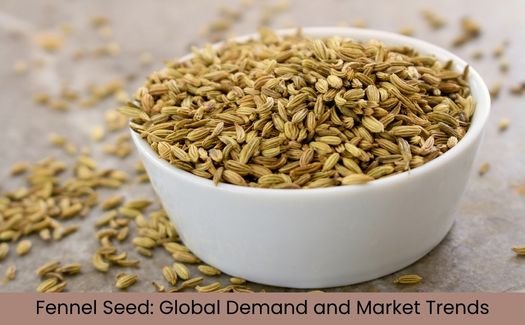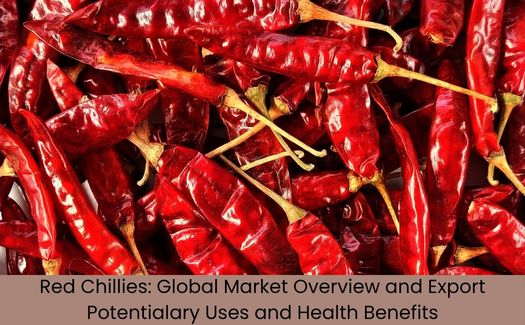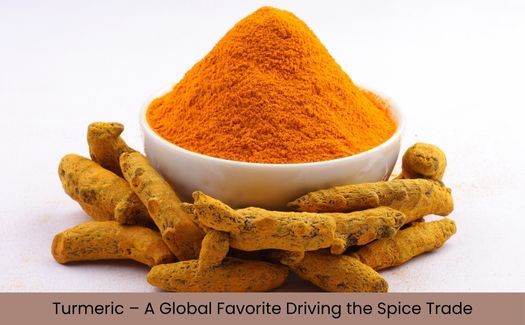Objective:
The objective of this article is to analyze the global market trends, export potential, and opportunities for leading whole spices such as cumin seed, fennel seed, fenugreek seed, coriander seed, dill seed, bishop’s seed, ajwain, red chillies, nigella seed, turmeric, cinnamon, bay leaf, and others. It aims to guide spice manufacturers and exporters on emerging markets, trade patterns, and value-addition strategies to enhance global competitiveness and profitability.
Introduction
The global demand for whole spices continues to rise as consumers seek natural flavoring agents, traditional remedies, and clean-label food ingredients. With increasing interest in ethnic cuisines, herbal wellness, and organic seasonings, the spice industry is witnessing strong growth across developed and emerging markets.
India remains the largest producer, exporter, and consumer of spices, supplying more than 70% of global spice varieties. However, opportunities are expanding in Asia-Pacific, Middle East, Europe, and North America, where food processors and retailers increasingly prefer traceable, high-quality, and sustainably sourced whole spices.
Let’s explore the market insights and export potential for key whole spices driving international trade.
Cumin Seed – A Global Favorite for Culinary and Health Applications
Market Overview:
Cumin seed is one of the most traded spices globally, with strong demand from the Middle East, Latin America, Europe, and the USA. India accounts for over 70% of world production, followed by Syria, Turkey, and Iran.
Export Potential:
- Major importers: USA, UAE, UK, Egypt, Saudi Arabia, and Brazil.
- Used in spice blends, pickles, bakery, and pharmaceuticals.
- Increasing demand for machine-cleaned, dehydrated, and steam-sterilized cumin seeds in premium markets.
Trend:
Rising popularity of Indian, Mexican, and Mediterranean cuisines boosts global consumption. Organic cumin is gaining traction in Europe and North America.
Fennel Seed – The Cooling Aromatic Spice
Market Overview:
Fennel seed is valued for its sweet aroma and digestive properties. It’s used in confectionery, liqueurs, teas, and spice mixes. India, Egypt, and China are major producers.
Export Potential:
- High demand in UAE, Malaysia, Singapore, Germany, and the USA.
- Favored by the food, pharmaceutical, and herbal tea industries.
- Organic fennel seeds fetch premium prices in Europe.
Trend:
Rising consumption of herbal beverages and sugar-free mouth fresheners drives global fennel seed exports.

Fenugreek Seed – The Functional Spice
Market Overview:
Fenugreek seed is recognized for its distinct flavor and medicinal benefits. It’s widely used in curry powders, pickles, animal feed, and dietary supplements.
Export Potential:
- Major importers: Egypt, USA, Germany, and South Africa.
- Increasing use in nutraceuticals and health foods.
- Demand for sterilized and low-microbial-load fenugreek for EU and US markets.
Trend:
Functional food and herbal supplement industries are driving growth for fenugreek exports globally.
Coriander Seed – The Universal Flavor Enhancer
Market Overview:
Coriander seed is a staple spice across continents, offering a mild citrusy flavor used in curries, sausages, and spice blends. India, Russia, and Morocco are major producers.
Export Potential:
- Key markets: USA, UK, UAE, Malaysia, and Germany.
- Used in food processing, beverages, and cosmetics.
- Demand for clean, split, and organic coriander seeds is increasing.
Trend:
Global consumption is rising due to growth in ready-to-cook spice mixes and processed foods.
Dill Seed – The Aromatic Preserver
Market Overview:
Dill seeds have a tangy aroma and are used in pickles, sauces, and herbal medicines. They also serve as a flavoring in fish dishes and vinegar preparations.
Export Potential:
- Key importers: Poland, Russia, USA, and Germany.
- Niche demand in natural medicine and herbal supplement markets.
Trend:
Growing preference for natural preservatives in food industries sustains export potential for dill seeds.
Bishop’s Seed (Ajwain) – The Digestive Spice
Market Overview:
Also known as Ajwain or Carom Seeds, Bishop’s Seed is known for its strong, thyme-like aroma. It is widely used in Indian, Middle Eastern, and African cuisines.
Export Potential:
- High demand in Gulf countries, UK, and North Africa.
- Growing popularity as a natural remedy for indigestion and flavoring agent in bakery items.
Trend:
Ajwain’s use in functional teas, digestive formulations, and ready-to-eat foods is expanding its market reach.
Red Chillies – The Fiery Export Leader

Market Overview:
Red chillies dominate the global spice trade, with India as the top exporter. Varieties such as S17 Teja, Byadgi, and 273 Wrinkle are globally recognized for color and pungency.
Export Potential:
- Major importers: China, USA, Thailand, Malaysia, and Sri Lanka.
- Export forms: Whole dried chillies, flakes, and crushed forms.
Trend:
Demand for low-pesticide, hygienically processed, and high-color-value chillies is increasing worldwide.
Nigella Seed (Kalonji) – The Black Gold of Spices
Market Overview:
Nigella seed, known as Kalonji or Black Cumin, is gaining global attention for its nutritional and therapeutic properties. It’s used in bakery toppings, pickles, and traditional medicine.
Export Potential:
- Growing demand in Europe, the Middle East, and North America.
- Used in organic and natural food industries.
Trend:
Kalonji’s recognition as a superfood ingredient is boosting its global export potential.
Bay Leaf – The Aromatic Culinary Leaf
Market Overview:
Bay leaves are used in soups, sauces, and marinades for their distinct aroma. The spice is traded widely across Europe, North America, and the Middle East.
Export Potential:
- India, Turkey, and Indonesia are key suppliers.
- High demand from the food and flavor industries.
Trend:
Processed and dried bay leaves with clean labeling and traceability are preferred by global buyers.
Turmeric – The Golden Spice of Global Trade
Market Overview:
Turmeric remains one of the most demanded whole spices globally. India dominates exports, followed by Myanmar and Indonesia.
Export Potential:
- Key importers: USA, UAE, Bangladesh, Japan, and the Netherlands.
- Used in food coloring, cosmetics, and nutraceuticals.
Trend:
Rising global preference for curcumin-rich and organic turmeric supports continued export growth.

Stevia Leaves – The Natural Sweetener Alternative
Market Overview:
Stevia leaves are gaining importance as a zero-calorie sweetener for beverages and food formulations.
Export Potential:
- Major demand in USA, Japan, and European markets.
- Preferred by food industries for sugar-free and diabetic-friendly products.
Trend:
Growing shift toward natural sugar substitutes drives Stevia export growth.
Chilly Flakes – A Versatile Culinary Ingredient
Market Overview:
Derived from dried red chillies, Chilly Flakes are used in pizzas, sauces, and processed foods for visual appeal and flavor enhancement.
Export Potential:
- Key markets: USA, Canada, Italy, and Australia.
- Widely used in food service and ready-to-eat products.
Trend:
High growth in the snack and fast-food sectors globally sustains demand for chilli flakes.
Cinnamon – The Sweet Aromatic Bark
Market Overview:
Cinnamon is among the most traded whole spices, valued for its sweet, woody aroma. Sri Lanka, India, and Indonesia are major exporters.
Export Potential:
- Primary markets: USA, UK, Germany, and the Middle East.
- Increasing demand in bakery, beverages, and health supplements.
Trend:
Ceylon cinnamon is highly sought-after for its delicate flavor and low coumarin content.
Senna Leaves and Pods – The Herbal Wellness Ingredient
Market Overview:
Senna leaves and pods are natural laxatives used in herbal medicine and pharmaceutical formulations. India and Egypt are major suppliers.
Export Potential:
- Main destinations: USA, Germany, UAE, and Sudan.
- High demand in herbal supplement industries.
Trend:
Rising global focus on natural detox and herbal wellness supports export growth for Senna-based products.
Sesame Seeds – The Nutritious Seed of Global Cuisine
Market Overview:
Sesame seeds are one of the oldest oilseeds known for their nutty flavor and nutritional value. Used in bakery, confectionery, and oil production.
Export Potential:
- Leading importers: Japan, South Korea, USA, and Middle East countries.
- White and hulled varieties command premium prices.
Trend:
Demand for organic, non-GMO sesame seeds is increasing, driven by health-conscious consumers.
Global Spice Market Outlook
- The global spice market is expected to surpass USD 110 billion by 2030, growing at a CAGR of 5–6%.
- Rising demand for natural flavorings, ethnic cuisines, and organic spices drives growth.
- The Asia-Pacific region remains the largest producer, while Europe and North America dominate premium import demand.
- Value-added products like cleaned, sorted, sterilized, and branded whole spices are seeing higher profitability.
Conclusion
The export potential for whole spices continues to expand across global markets. With increasing awareness of natural food ingredients and functional benefits, exporters have opportunities to scale through quality assurance, organic certification, traceability, and branding.
Spice manufacturers should focus on modern processing, packaging, and compliance with international standards such as ASTA, ISO, and HACCP to strengthen their global presence. By combining traditional cultivation with modern trade practices, the spice industry can unlock significant growth in the coming decade.
FAQs About Whole Spices
Which countries are the top importers of whole spices?
The USA, UAE, Germany, UK, Malaysia, and Saudi Arabia are leading importers of whole spices.
What factors influence global spice export demand?
Key factors include taste trends, organic certification, food safety regulations, and consumer preference for natural ingredients.
How can spice exporters increase profitability?
By investing in value addition – cleaning, grading, steam sterilization, and sustainable packaging.
Which spice has the highest export potential?
Cumin, turmeric, red chillies, sesame seeds, and cinnamon currently lead in global export growth.

